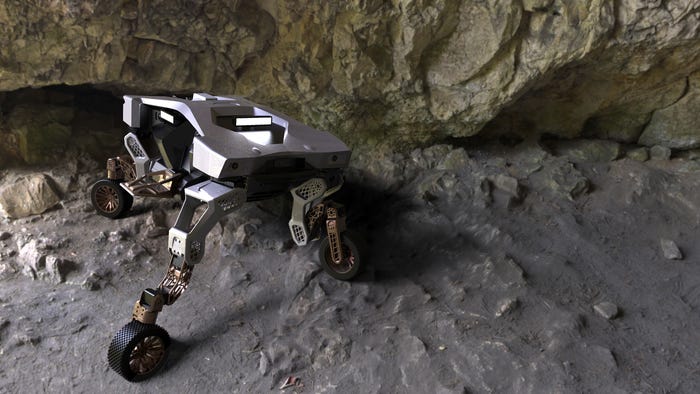The robo-vehicle combines legs and wheels
February 12, 2021

The robo-vehicle combines legs and wheels for better mobility
Korean car-maker Hyundai has provided a dramatic vision of the future of autonomous systems by revealing a new concept called TIGER.
Billed as the company’s first unscrewed ultimate utility vehicle (UMV), TIGER is essentially a four-legged robotic walking machine with four-wheel drive capability.
The outrageous creation has been developed by Hyundai Motor Group’s New Horizon Studio based in Mountain View, California, and gives a tantalizing glimpse of the endless potential for autonomous vehicles in the years ahead.
Rethinking vehicle design
TIGER – an acronym for Transforming Intelligent Ground Excursion Robot – is attempting to showcase what AI-based systems could achieve in remote, inaccessible locations. It has even been suggested that it would have the capability to explore the surface of the moon, or another planet.
It has been designed to connect with unmanned aerial vehicles (UAVs) for charging and delivery to exotic destinations, where its sophisticated leg and wheel system would help provide 360-degree mobility. There is also a range of sensors for remote observation.
A large load bay housed within its body would make TIGER ideal for delivering supplies or aid packages to disaster zones where access for conventional vehicles proved difficult.
Leg-wheel articulation enables TIGER to tackle a range of extreme terrains while keeping payloads more level than a typical ground vehicle.

© Hyundai
Under normal conditions, TIGER would use its wheels to make progress. But when the terrain gets too challenging or impassable, the legs would be employed to ‘walk’ and ensure it doesn’t get stuck. This mirrors a feature first seen in Hyundai’s Elevate concept at CES in 2019, which was unable to operate without a crew.
“Vehicles like TIGER, and the technologies underpinning it, give us an opportunity to push our imaginations,” Dr. John Suh, head of New Horizons Studio, said. “We are constantly looking at ways to rethink vehicle design and development and re-define the future of transportation and mobility.”
Also involved in the project are engineering design software company Autodesk, and Michigan-based design experts Sundberg-Ferar.
According to David Byron, manager of Design and Innovation Strategy at Sundberg-Ferar, the innovative construction means further evolution from the initial concept is ppossible. He explained: “TIGER is a modular platform design allowing different bodies to be attached to the chassis for unique applications…in locations not suitable for humans.”
So when can we expect a mega-drone or other UAV to deliver the TIGER into reality? There are multiple obstacles to be negotiated before that happens, but reports suggest testing of beta-stage models might be feasible by 2023 or 2024.
About the Author(s)
You May Also Like
.jpg?width=700&auto=webp&quality=80&disable=upscale)
.jpg?width=700&auto=webp&quality=80&disable=upscale)
.jpg?width=700&auto=webp&quality=80&disable=upscale)


.jpg?width=300&auto=webp&quality=80&disable=upscale)

.jpg?width=300&auto=webp&quality=80&disable=upscale)